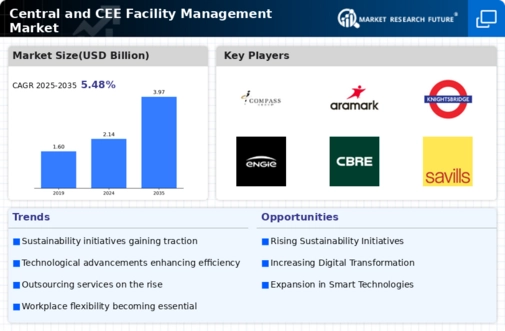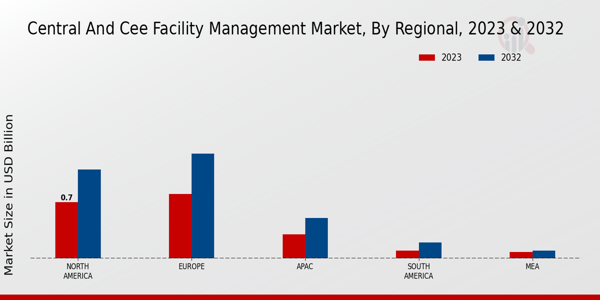Market Growth Projections
The Global Central and CEE Facility Management Market Industry is poised for substantial growth, with projections indicating a market size of 2.14 USD Billion in 2024 and an anticipated increase to 3.97 USD Billion by 2035. This growth trajectory suggests a compound annual growth rate (CAGR) of 5.75% from 2025 to 2035, reflecting the increasing demand for facility management services across various sectors. As organizations continue to prioritize efficiency, sustainability, and technological integration, the market is likely to expand, driven by these key factors.
Expansion of Outsourcing Trends
The trend towards outsourcing facility management services is gaining momentum within the Global Central and CEE Facility Management Market Industry. Organizations are increasingly recognizing the benefits of outsourcing non-core functions to specialized service providers, allowing them to focus on their primary business objectives. This shift is driven by the need for cost efficiency and access to expertise in facility management. As a result, the market is expected to grow, with more companies opting for outsourced solutions to enhance operational efficiency and service quality.
Growing Demand for Sustainable Practices
The Global Central and CEE Facility Management Market Industry experiences a notable shift towards sustainability, driven by increasing environmental awareness among businesses and consumers. Organizations are increasingly adopting green building practices, which not only reduce carbon footprints but also enhance operational efficiency. For instance, the integration of energy-efficient systems and sustainable materials is becoming commonplace. This trend is expected to contribute to the market's growth, as companies seek to align with global sustainability goals. By 2024, the market is projected to reach 2.14 USD Billion, reflecting a strong commitment to sustainable facility management solutions.
Rising Focus on Health and Safety Standards
The emphasis on health and safety standards within facilities is becoming increasingly pronounced in the Global Central and CEE Facility Management Market Industry. Organizations are prioritizing the well-being of employees and visitors, leading to the implementation of stringent safety protocols and maintenance practices. This focus on health and safety not only enhances workplace environments but also mitigates risks associated with facility management. As businesses strive to comply with regulatory requirements and improve employee satisfaction, the demand for comprehensive facility management services is likely to rise, contributing to market growth.
Technological Advancements in Facility Management
Technological innovation plays a pivotal role in shaping the Global Central and CEE Facility Management Market Industry. The adoption of smart building technologies, including IoT and AI, enhances operational efficiency and reduces costs. These technologies facilitate real-time monitoring and predictive maintenance, which can significantly lower downtime and improve service delivery. As organizations increasingly invest in digital transformation, the market is likely to witness substantial growth. By 2035, the market is anticipated to expand to 3.97 USD Billion, indicating a robust trajectory fueled by technological advancements.
Increasing Urbanization and Infrastructure Development
Urbanization continues to surge across Central and Eastern Europe, driving the demand for effective facility management solutions. The Global Central and CEE Facility Management Market Industry is influenced by the rapid development of urban infrastructure, which necessitates efficient management of facilities. As cities expand, the complexity of managing various facilities increases, prompting organizations to seek specialized facility management services. This trend is expected to propel market growth, as urban centers require innovative solutions to address the challenges posed by increased population density and infrastructure demands.























Leave a Comment